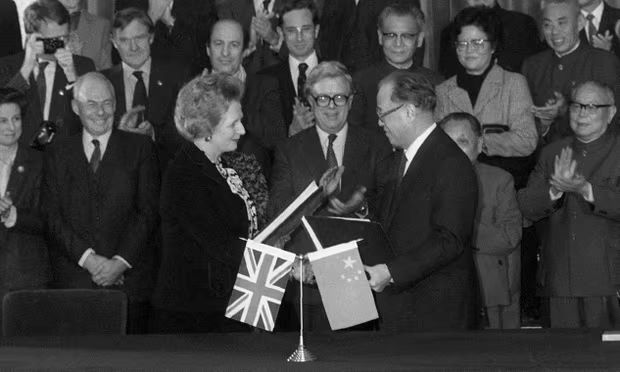In the Hall of the People in Beijing, British Prime Minister Margaret Thatcher and Chinese Premier Zhao Ziyang signed an agreement on this day in 1984 committing Britain to return Hong Kong to China in 1997 in return for terms guaranteeing a 50-year extension of its capitalist system. Hong Kong–a small peninsula and group of islands jutting out from China’s Kwangtung province–was leased by China to Great Britain in 1898 for 99 years.
In 1839, in the First Opium War, Britain invaded China to crush opposition to its interference in the country’s economic, social, and political affairs. One of Britain’s first acts of war was to occupy Hong Kong, a sparsely inhabited island off the coast of southeast China. In 1841, China ceded the island to the British with the signing of the Convention of Chuenpi, and in 1842 the Treaty of Nanking was signed, formally ending the First Opium War. At the end of the Second Opium War (1856-1860), China was forced to cede the Kowloon Peninsula, adjacent to Hong Kong Island, along with other area islands.
Britain’s new colony flourished as an East-West trading centre and as the commercial gateway and distribution centre for southern China. On July 1, 1898, Britain was granted an additional 99 years of rule over the Hong Kong colony under the Second Convention of Peking. Hong Kong was occupied by the Japanese from 1941 to 1944 during World War II but remained in British hands throughout the various Chinese political upheavals of the 20th century.
On December 19, 1984, after years of negotiations, British and Chinese leaders signed a formal pact approving the 1997 turnover of the colony in exchange for the formulation of a “one country, two systems” policy by China’s communist government. Prime Minister Margaret Thatcher called the agreement “a landmark in the life of the territory, in the course of Anglo-Chinese relations, and in the history of international diplomacy.” Hu Yaobang, the Chinese Communist Party’s secretary-general, called the signing “a red-letter day, an occasion of great joy” for China’s one billion people.
At midnight on July 1, 1997, Hong Kong was peaceably handed over to China in a ceremony attended by numerous international dignitaries, including British Prime Minister Tony Blair, Prince Charles, Chinese President Jiang Zemin, and US Secretary of State Madeleine Albright. A few thousand citizens of Hong Kong protested the turnover, which was otherwise celebratory and peaceful. The chief executive of the new Hong Kong government, Tung Chee Hwa, did enact a policy based upon the concept of one country, two systems, thus preserving Hong Kong’s role as a principal capitalist centre in Asia.
Massive anti-government protests in Hong Kong began in June 2019, when more than one million people marched to protest a bill that would allow the extradition of people to mainland China to stand trial. The bill was later dropped, but anti-government unrest remains.
-history.com
Photo Caption – On December 19, 1984 British Prime Minister Margaret Thatcher and Chinese Premier Zhao Ziyang agree on a Hong Kong handover in 1997 – Pierre-Antoine Donnet/AFP/Getty Images



Comments are closed, but trackbacks and pingbacks are open.